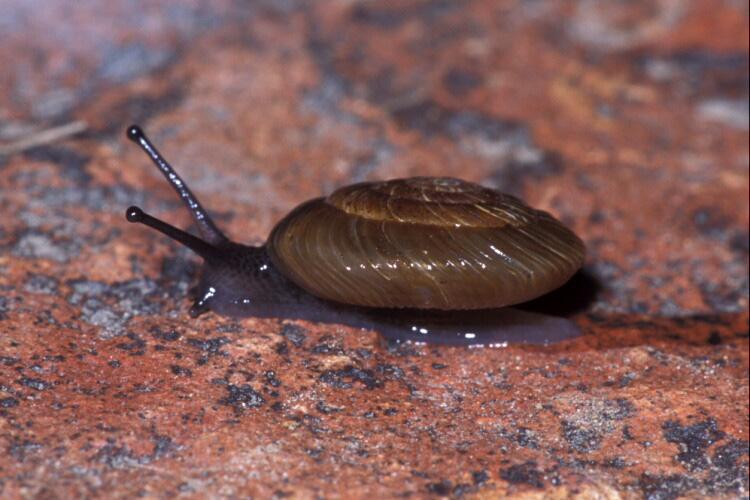The population size of the Nimapuna tigersnail is critical and the trend is unknown. These terrestrial snails are very rare and have distributions that include small, isolated populations, perhaps remnants of previously much wider ranges. These small, isolated populations, often associated with old-growth and/or riparian hardwoods and are very vulnerable to logging, road building, fires, or other disturbances.
Description and Range
Physical description
Taxonomic note: nimapuna tigersnail is in the family Discidae. This species appears to be an undescribed subspecies; they are distinctly like A. nimapuna from Idaho, but are smaller, with thinner shells and with weaker rib sculpturing.
Ecology and life history
In Idaho this species has been found between 1500 to 2550 feet in elevation at sites with an overstory that included western red-cedar and grand fir, with some alder, paper birch, Douglas-fir and/or ponderosa pine; often under wood or on bryophyte mats among dense ferns.
Land snails are hermaphroditic and exchange gametes with other conspecific individuals when conditions are favorable, typically in the spring, and then both will lay eggs in damp subsurface situations where the eggs will be relatively safe from predators and desiccation. Land snails do not tend their eggs or young. There is no larval stage and newborn snails look like miniature adults (the innermost part of the shell develops within the egg).
Snails need moisture, so where the habitat dries out, they will estivate in the summer, become active with fall rains, and hibernate when the season turns cold.
Land snails eat plants (living or dead), fungi, fruit, microorganisms, litter, wood, and dead animals.
During the summer, snails are found deep in talus accumulations which are adjacent to springs or streams and which serve as refuge sites from desiccation and protection from predators while the snails are immobile. These deep rock refugia also provide the important, environmentally stable sites needed to survive wildfire events and cold winter conditions.
Mollusks which inhabit talus habitats also utilize the surrounding forest areas during moist, cool conditions, ranging out from the refugia provided by the rocks to forage in the adjacent forest floor litter.
Geographic range
This yet-to-be described subspecies occurs at two locations on ridges on opposite sides of Lake Chelan, Chelan County, Washington. Outside of Washington, this species is known from less than 10 localities in the Clearwater, Lochsa, and Selway Rivers’ drainages in Idaho County, Idaho, and Wallowa County, Oregon.
Conservation
Conservation Threats and Actions Needed
- Resource information collection needs
- Threat: Lack of data; need species distribution data.
- Action Needed: Describe and protect sites.
- Threat: Possible new subspecies; need taxonomic clarification.
- Action Needed: Clarify taxonomy.
Resources
References
Applegarth, J. S. 2000. Management recommendations for terrestrial mollusk species Megomphix hemphilli the Oregon Megomphix. Version 2.0. Unpublished report to the Oregon Bureau of Land Management. 39 pp.
Burke, T. E. 2013. Land Snails and Slugs of the Pacific Northwest. Oregon State University Press, Corvallis, OR. 344 pp.
Burke, T. E. Personal communications.
Duncan, N. 2005. Conservation Assessment for Monadenia fidelis minor, Dalles Sideband. Originally issued as Management Recommendations by T. R. Weasma, 1998. Revised by N. Duncan. USDA Forest Service Region 6 and USDI Bureau of Land Management, Oregon and Washington, 14pp.
Frest, T. J. 1999. A Review of the land and freshwater Mollusks of Idaho. Final report to the Idaho Conservation Data Center, Idaho Department of Fish and Game, 600 South Walnut, P.O. Box 25, Boise, Idaho 83707. 281 pp. plus appendices.
Hendricks, P., B. A. Maxell and S. Lenard. 2006. Land Mollusk Surveys on USFS Northern Region Lands. A report to the USDA Forest Service, Northern Region. Montana Natural Heritage Program, Helena, Montana. 11 pp. plus appendices.
NatureServe. 2014. NatureServe Explorer: An online encyclopedia of life [web application]. Version 7.1. NatureServe, Arlington, Virginia. Available http://explorer.natureserve.org. (Accessed September 11, 2014 ).
Pilsbry, H. A. 1948. Land Mollusca of North America (north of Mexico). Monograph of the Academy of Natural Sciences of Philadelphia, 2(2): 521-1113.
Stone, T., 2009. Crowned Tightcoil (Pristiloma pilsbryi). Species Fact Sheet. Interagency Special Status/Sensitive Species Program, Forest Service, Bureau of Land Management. 5pp.
USFWS. 2011. Endangered and Threatened Wildlife and Plants: 90-day finding on a petition to list 29 mollusk species as threatened or endangered with critical habitat: proposed rule. Federal Register 76 (No. 193, October 5, 2011): 61826-61853.
